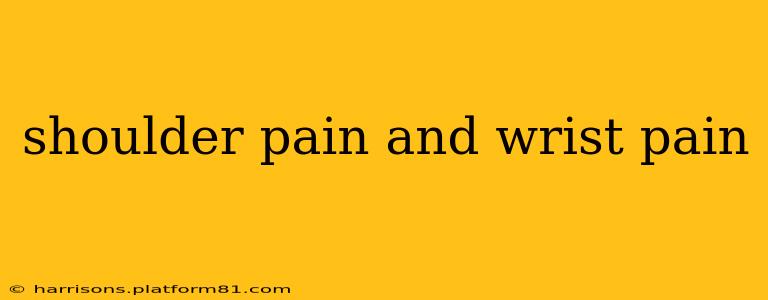Shoulder and wrist pain are incredibly common complaints, affecting people of all ages and activity levels. While seemingly unrelated, these two areas are interconnected through the complex network of nerves, muscles, and tendons that run through the arm. Understanding the potential causes, symptoms, and treatments for both shoulder and wrist pain is crucial for effective management and relief. This comprehensive guide will explore the various possibilities, helping you understand your specific situation and navigate the path to recovery.
What Causes Shoulder Pain?
Shoulder pain can stem from a variety of sources, ranging from minor muscle strains to serious injuries. Some of the most frequent culprits include:
-
Rotator Cuff Injuries: The rotator cuff is a group of muscles and tendons that stabilize the shoulder joint. Tears, inflammation (tendinitis), or impingement (pinching) of these structures are common causes of shoulder pain. Activities involving repetitive overhead movements, sudden injuries, or aging can contribute.
-
Bursitis: Bursae are fluid-filled sacs that cushion the shoulder joint. Bursitis, or inflammation of these sacs, can cause significant pain and limited range of motion.
-
Arthritis: Osteoarthritis and rheumatoid arthritis can affect the shoulder joint, leading to pain, stiffness, and reduced mobility.
-
Frozen Shoulder (Adhesive Capsulitis): This condition involves the thickening and tightening of the shoulder joint capsule, resulting in significant pain and stiffness.
-
Muscle Strains: Overexertion or improper lifting can strain the muscles surrounding the shoulder, causing pain and discomfort.
What Causes Wrist Pain?
Wrist pain, much like shoulder pain, has a diverse range of potential causes:
-
Carpal Tunnel Syndrome: This common condition occurs when the median nerve, which runs through the carpal tunnel in the wrist, becomes compressed. Symptoms include numbness, tingling, and pain in the thumb, index, middle, and ring fingers.
-
Tenosynovitis (De Quervain's Tenosynovitis): Inflammation of the tendons on the thumb side of the wrist, often caused by repetitive hand movements.
-
Wrist Sprains: These injuries occur when the ligaments in the wrist are stretched or torn, often resulting from a fall or impact.
-
Fractures: A fall or blow to the wrist can cause a fracture of one or more bones.
-
Arthritis: Similar to the shoulder, arthritis can affect the wrist joint, causing pain, swelling, and stiffness.
Can Shoulder Pain Cause Wrist Pain?
While not directly causing wrist pain in a causal way, shoulder problems can indirectly lead to wrist discomfort. For example, if shoulder pain causes you to alter your posture or compensate with different movements, it can strain your wrist and hand over time. This is especially true for individuals who rely heavily on their hands for daily activities. This compensatory movement can put extra stress on the wrist, leading to pain and discomfort.
Can Wrist Pain Cause Shoulder Pain?
Similarly, chronic wrist pain can sometimes lead to shoulder pain through a process of compensation. If someone experiences significant wrist pain, they might subconsciously alter their posture or movement patterns to reduce stress on the wrist. These changes can, in turn, strain the shoulder muscles and joints, contributing to shoulder pain.
How are Shoulder and Wrist Pain Diagnosed?
Diagnosis typically begins with a thorough physical examination by a doctor or physical therapist. They will assess your range of motion, palpate for tenderness, and inquire about your medical history and symptoms. Imaging tests, such as X-rays, MRI scans, or ultrasound, may be necessary to visualize the affected area and rule out fractures, arthritis, or other conditions. In some cases, nerve conduction studies may be used to diagnose conditions like carpal tunnel syndrome.
What are the Treatments for Shoulder and Wrist Pain?
Treatment options for shoulder and wrist pain vary depending on the underlying cause and severity. Common approaches include:
-
Rest and Ice: For minor injuries, resting the affected area and applying ice can help reduce inflammation and pain.
-
Over-the-Counter Pain Relievers: Nonsteroidal anti-inflammatory drugs (NSAIDs), such as ibuprofen or naproxen, can help alleviate pain and inflammation.
-
Physical Therapy: A physical therapist can teach you exercises and stretches to improve range of motion, strengthen muscles, and improve overall function.
-
Corticosteroid Injections: Injections of corticosteroids can reduce inflammation in the affected joint or tendon.
-
Surgery: In some cases, surgery may be necessary to repair a torn rotator cuff, correct a fracture, or address other severe conditions.
This information is for general knowledge and does not constitute medical advice. Always consult with a healthcare professional for diagnosis and treatment of shoulder and wrist pain. They can provide personalized recommendations based on your specific situation and medical history.
